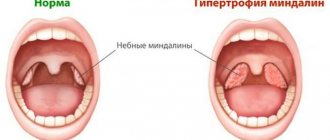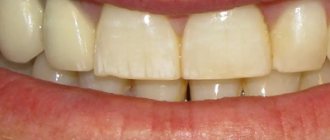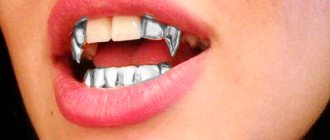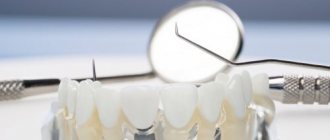October 11, 2010 - Monday
The position of a successful person today is a health fashion: playing sports, giving up bad habits, visiting cosmetologists and massage therapists... However, not everyone, not everyone, monitors the condition of their teeth. And an important role in this is played by misconceptions that have taken root in people’s minds. Indeed, in the age of developed technologies and the active implementation of innovative projects, the other side of the crazy intensification of life is the desire to get away from the hustle and bustle and the desire to believe in the miraculous and unreal.
However, if you still think that dental treatment is painful, or that a miracle paste will preserve your smile, and chewing gum will protect you from caries, congratulations, you still have not managed to separate myths and reality, and your knowledge Dentistry is full of prejudices.
How to ensure that these stereotypes, or one might say myths, do not prevent you from taking care of your smile and what really needs to be done to correct the situation, will be explained by the chief dentist of the Sverdlovsk region, Doctor of Medical Sciences, Professor, Head of the Regional Dental Clinic Marina Pavlovna Kharitonova .
Fact : The Sverdlovsk region is one of the regions with a high prevalence and average intensity of dental diseases: 14% of 6-year-old children already have permanent teeth affected by caries. Recently, diseases of periodontal tissues have also become much “younger” - more than half of adolescents aged 12-15 years have been diagnosed with tartar and increased bleeding of the gums. 96% of people over 35-40 years old have teeth affected by caries and inflammatory processes in the tissues surrounding the teeth (periodontitis). More than 70% of people over 65 years of age need orthopedic treatment, i.e. in prosthetics.
No one has ever died from a bad tooth
Reality: Infection coming from a diseased tooth (odontogenic infection) is one of the most dangerous. A diseased tooth is a source of pathogenic environment in the body. Numerous colonies of microorganisms live and multiply in the mouth, some of them quite aggressive. From a “neglected” diseased tooth, microbes can travel throughout the body, both independently and by causing allergization of the body, which leads to a decrease in immunity. In addition, ulcers on the roots with a decrease in immunity can lead to the development of serious complications (abscesses, phlegmon, osteomyelitis, etc.), and sometimes cause conditions incompatible with life.
Fact: Scientists have proven that the presence of multiple chronic foci of infection in untreated teeth in pregnant women leads to miscarriage and low fetal weight during childbirth.
What to do?
At least 1-2 times a year, undergo examination and professional hygiene at the dentist, which will help identify and effectively eliminate pathology in the initial stages of development.
Fact: Expenses of Russian residents, according to data at the beginning of the century, on certain types of goods and services (per year): - for vodka, beer, cigarettes - $12 billion, - for medicines - $2.2 billion, - for dental care – $600 million
Cardiovascular diseases
Pathogenic microorganisms that cause inflammation in the oral cavity can negatively affect the functioning of the heart and blood vessels. If you ignore the problem and do not carry out timely treatment, then the infection may soon migrate from the source of inflammation through the bloodstream to the heart.
Infection provokes a number of progressive pathological processes in this organ. Metabolism is disrupted, toxic waste products of microbes are formed. As a result, infectious agents infect organ tissues and create foci of secondary infection in them. As a result, the likelihood of pericarditis, endocarditis and other diseases increases.
The vessels through which the pathogen moves to the heart also become the target of damage. Their walls become inflamed, increasing the likelihood of hemorrhages, blood clots, blood pressure surges, etc.
If a tooth falls out, you can do just fine without it.
Reality: Each tooth in our wide smile is a link in the dental chain. Each group of teeth performs its own function: some bite off food, others chew it. When a tooth is removed or falls out, the shape of the teeth and jaws changes. The teeth adjacent to the missing one begin to shift and fill the vacated space, which can subsequently cause difficulties with prosthetics.
Fact: Significant tooth loss leads to eating more monotonous and less balanced food, a lack of vitamins and microelements, which can affect brain activity.
What to do?
Lost teeth need to be restored, which can be done in various ways. The options of choice are restorative orthopedic structures supported either by implants or by natural teeth. Fact: The fewer natural teeth a person has, the higher the risk of developing coronary heart disease and heart attack. People with fewer than 10 natural teeth are seven times more likely to die from a heart attack than those with more than 25 teeth.
Why is caries dangerous?
- Inflammation of the pulp, gums and periodontal tissues (accompanied by pain, swelling of the cheeks and gums, as well as increased sensitivity of the teeth)
- Problems with the cardiovascular system, digestive tract and joints
- Complete loss of teeth (the tooth may completely rot or fall out)
- Cyst formation (can lead to cancer and blood poisoning)
- Spread of caries to adjacent teeth
- You cannot perform dental implantation in Minsk or prosthetics (the doctor will not be able to install implants and dentures on diseased teeth)
- Bad breath
- The aesthetic component of the dentition suffers
- Psychological problems (a person begins to feel embarrassed about his smile, avoids communicating with people, withdraws into himself and may become depressed)
It is worth noting that advanced caries is much more difficult to treat. It requires a lot of attention, time, effort and nerves. In addition, to get rid of this disease you will need the help of highly qualified specialists, as well as a painless treatment method. The Family Dentistry Center offers its clients dental treatment under general anesthesia with the use of drug sedation. It is safe for the body and allows treatment to be carried out during sleep without causing pain or discomfort. The patient is administered the drug Propofol, thanks to which he can completely relax and calm down. Salivation is reduced and the pain threshold is significantly increased, while the entire treatment process is supervised by a team of anesthesiologists.
Chewing gum, floss and toothpaste are a panacea for caries
Reality: Even the best toothpaste in the world will not cure your tooth! Chewing gum only restores the acid-base balance disturbed during meals. Floss, or, as they more often say, dental floss, is also not a doctor for our teeth. All of the above remedies are good for preventing the occurrence of carious lesions, but given the existing pathology, they are not able to not only cure, but even stop the process.
What to do?
It is necessary to use all of the above means, but only along with systematic visits to the dental office for preventive examinations, professional hygiene and sanitation of the oral cavity, i.e. treatment and maintenance in proper condition of all teeth with one or another pathology.
PRINCIPLES OF TREATMENT OF INFECTIONS OF THE ORAL CAVITY AND MAXILLOFACIAL AREA
Treatment of odontogenic infection
often limited to local therapy, including standard dental procedures.
Systemic antibacterial therapy is carried out only when odontogenic infection spreads beyond the periodontal period (under the periosteum, into the bones, soft tissues of the face and neck), in the presence of elevated body temperature, regional lymphadenitis, and intoxication.
When choosing antimicrobial therapy in a hospital setting, in cases of severe purulent infection, it is necessary to take into account the possibility of the presence of resistant strains among anaerobes such as Prevotella
spp.,
F. nucleatum
to penicillin, which determines the prescription of broad-spectrum drugs, amoxicillin/clavulanate in monotherapy or a combination of fluoroquinolone with metronidazole.
Due to increasing levels of resistance by Streptococcus
spp.
to tetracycline and erythromycin, these drugs can only be used as alternatives. Since metronidazole has moderate activity against anaerobic cocci ( Peptostreptococcus
spp.), simultaneous administration of β-lactam antibiotics is necessary to increase effectiveness.
Preventive systemic use of AMPs when performing dental procedures in the oral cavity or periodontium does not guarantee a reduction in the incidence of infectious complications in somatically healthy patients. Convincing data on the sufficient effectiveness of topical antibiotics for oral infections have not been obtained. At the same time, oral bacteria are a reservoir of determinants of resistance to AMPs. Excessive and unjustified use of antibiotics contributes to their appearance and the development of resistance of pathogenic microflora.
The more expensive the toothbrush and toothpaste, the better they are.
Reality: The cost of hygiene products is not an indicator of their usefulness specifically for you. The structure of dental tissues, their location, color, shape, as well as characters, are different for everyone.
What to do?
The selection of oral hygiene products should only be carried out by your treating dentist. In addition, the doctor will evaluate the correctness of your usual cleaning method and make the necessary adjustments.
Fact: The quality of teeth cleaning is influenced not so much by the toothbrush and toothpaste you choose, but by the correctness and duration of this manipulation. It has been proven that with a recommended time of about 3-5 minutes, most often the average person on the planet spends about 30 seconds brushing their teeth. Tip: To stay on time, turn on your favorite song and brush your teeth from the first chord to the last. On average, the duration of songs is the 3-5 minutes we need. Both fun and useful!
Recommendations
The longer you ignore a bad tooth and hope that the problem will go away on its own, the more difficult and painful its treatment will be. To prevent oral diseases, it is recommended: 1.
- Carry out regular dental hygiene, annual professional teeth cleaning, and procedures to strengthen dental tissue.
- Watch your diet and limit sweets.
- Treat chronic diseases.
And of course, you should visit the dentist promptly. Even if nothing worries you, a preventative annual examination will help make sure there are no pathological processes. After all, there are diseases that make themselves felt at an advanced stage of development.
If you take several x-rays in a row, you can get high levels of radiation
Reality: According to one of the leading specialists in dental radiology, D.V. Rogatskin, one intraoral photograph of a tooth corresponds to approximately one microsievert.
The radiation dose when taking one three-dimensional image on a dental tomograph is approximately equal to the radiation dose from a panoramic image and is about 20-50 microsieverts. What to do?
You should not apply to a peaceful dental office the same concepts that are used at a nuclear test site. During the treatment process, you can and should take as many x-rays as your doctor needs, and if necessary, do not be afraid to do 1-2 studies per year on a dental tomograph. It is necessary to understand that your attending physician takes a picture, or a series of pictures, so that the quality of treatment is at the proper level and the tooth will serve you for many more years. And such a modern method as tomography of the maxillofacial area goes beyond the boundaries of conventional x-ray examination and often allows the doctor to see in volumetric form the pathology that cannot be determined on ordinary photographs.
Protozoa
The decomposed cellular substrate in the organ is attacked by protozoa, which, processing this waste, act as garbage collectors in containers. Thus, dead cells, bacteria, and toxins are not just scattered throughout the organ, but cleaned, aligned cavities. This process is dynamic, each type of introduced microorganisms has time to become saturated and grow, multiply, that is, give birth to offspring.
The process continues until the immune system says: stop! It sends lymphocytes, leukocytes, macrophages, antibodies, sends energy and, depending on how well they cope, either recovery, improvement, remission (subsidence) occurs, or the disease turns into a sluggish chronic process. Protozoa are localized in the skin, eyes, tongue, intestines, liver, kidneys, bladder, genitals, etc.
Heredity is to blame for bad teeth
Reality : The role of heredity in the health of our teeth is extremely small and is manifested in the structure and properties of tooth tissue: enamel and dentin. In fact, a person even with not very good heredity has every chance of keeping his teeth healthy.
What to do?
Take proper care of your teeth throughout your life and make regular visits to your dentist.
Fact: Today, there is an opposite theory that lesions of specific teeth may indicate a predisposition to the pathology of a particular organ or an already existing disease.
Correlation of teeth affected by caries with pathology of internal organs
Diseases of the gastrointestinal tract
Pathogenic microbes from the oral cavity easily migrate with food into the gastrointestinal tract. When they enter the digestive organs, they cause irritation of the mucous membrane. At best, this leads to digestive disorders, for example, bloating, heartburn, and bowel dysfunction.
But if the number and growth of pathogenic microorganisms rapidly increases, then very soon a person feels the first symptoms of gastritis, stomach ulcers or colitis.
In addition, diseased teeth are not able to cope with their main task. The process of chewing food is disrupted, the load on the digestive organs increases, which also negatively affects the functioning of the gastrointestinal tract.










